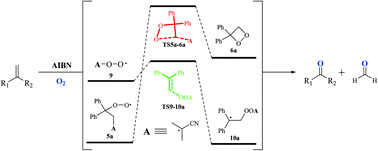A computational study of the reaction mechanism of 2,2-azobis(isobutyronitrile)-initiated oxidative cleavage of geminal alkenes†
Abstract
A computational study of 2,2-azobis(isobutyronitrile) (AIBN)-initiated aerobic oxidative cleavage of alkenes is carried out employing density functional theory (DFT) and high-level coupled-cluster methods, such as coupled-cluster singles and doubles with perturbative triples [CCSD(T)]. Our computations show that the barriers for the formation of dioxetane derivatives suggested by Xu and co-workers (J. Org. Chem., 2014, 79, 7220–7225) for the reaction mechanism of aerobic oxidative cleavage of alkenes are computed to be higher than 65 kcal mol−1. This barrier is relatively high under the reaction conditions. Our results for the Xu mechanism indicate that the reaction does not proceed via the formation of a dioxetane ring under the reaction conditions. Our results demonstrate that the reaction of aerobic oxidative cleavage of geminal alkenes in the presence of AIBN is initiated by the peroxyl radical 9, contrary to the isobutyronitrile radical 2. Our results show that the 2-(2-hydroxyl-1,1-diarylethoxy)-2-methylpropanenitrile radical (15) does not appear throughout the reaction scheme and the reaction progresses over the 2-(2-hydroxyl-2,2-diarylethoxy)-2-methylpropanenitrile radical (13) rather than the 2-(2-hydroxyl-1,1-diarylethoxy)-2-methylpropanenitrile radical (15). Our results are in agreement with the experimental results for the aerobic oxidative cleavage of the geminal disubstituted alkenes. Our results also demonstrate that the epoxide derivatives can be formed as an intermediate under the reaction conditions. This reaction is not applicable for pyridine derivatives due to the conversion of vinylpyridine derivatives to N-oxide derivatives.

- This article is part of the themed collection: Mechanistic, computational & physical organic chemistry in OBC


 Please wait while we load your content...
Please wait while we load your content...